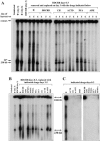Impact of 2-bromo-5,6-dichloro-1-beta-D-ribofuranosyl benzimidazole riboside and inhibitors of DNA, RNA, and protein synthesis on human cytomegalovirus genome maturation
- PMID: 16103162
- PMCID: PMC1193602
- DOI: 10.1128/JVI.79.17.11115-11127.2005
Impact of 2-bromo-5,6-dichloro-1-beta-D-ribofuranosyl benzimidazole riboside and inhibitors of DNA, RNA, and protein synthesis on human cytomegalovirus genome maturation
Abstract
Herpesvirus genome maturation is a complex process in which concatemeric DNA molecules are translocated into capsids and cleaved at specific sequences to produce encapsidated-unit genomes. Bacteriophage studies further suggest that important ancillary processes, such as RNA transcription and DNA synthesis, concerned with repeat duplication, recombination, branch resolution, or damage repair may also be involved with the genome maturation process. To gain insight into the biochemical activities needed for herpesvirus genome maturation, 2-bromo-5,6-dichloro-1-beta-d-ribofuranosyl benzimidazole riboside (BDCRB) was used to allow the accumulation of human cytomegalovirus concatemeric DNA while the formation of new genomes was being blocked. Genome formation was restored upon BDCRB removal, and addition of various inhibitors during this time window permitted evaluation of their effects on genome maturation. Inhibitors of protein synthesis, RNA transcription, and the viral DNA polymerase only modestly reduced genome formation, demonstrating that these activities are not required for genome maturation. In contrast, drugs that inhibit both viral and host DNA polymerases potently blocked genome formation. Radioisotope incorporation in the presence of a viral DNA polymerase inhibitor further suggested that significant host-mediated DNA synthesis occurs throughout the viral genome. These results indicate a role for host DNA polymerases in genome maturation and are consistent with a need for terminal repeat duplication, debranching, or damage repair concomitant with DNA packaging or cleavage. Similarities to previously reported effects of BDCRB on guinea pig cytomegalovirus were also noted; however, BDCRB induced low-level formation of a supergenomic species called monomer+ DNA that is unique to human cytomegalovirus. Analysis of monomer+ DNA suggested a model for its formation in which BDCRB permits limited packaging of concatemeric DNA but induces skipping of cleavage sites.
Figures






Similar articles
-
Dramatic effects of 2-bromo-5,6-dichloro-1-beta-D-ribofuranosyl benzimidazole riboside on the genome structure, packaging, and egress of guinea pig cytomegalovirus.J Virol. 2004 Feb;78(4):1623-35. doi: 10.1128/jvi.78.4.1623-1635.2004. J Virol. 2004. PMID: 14747528 Free PMC article.
-
Inhibition of human cytomegalovirus DNA maturation by a benzimidazole ribonucleoside is mediated through the UL89 gene product.J Virol. 1998 Jan;72(1):717-25. doi: 10.1128/JVI.72.1.717-725.1998. J Virol. 1998. PMID: 9420278 Free PMC article.
-
A Guinea pig cytomegalovirus resistant to the DNA maturation inhibitor BDCRB.Antiviral Res. 2018 Jun;154:44-50. doi: 10.1016/j.antiviral.2018.04.006. Epub 2018 Apr 9. Antiviral Res. 2018. PMID: 29649495 Free PMC article.
-
Focus on new drugs in development against human cytomegalovirus.Drugs. 2002;62(13):1853-8. doi: 10.2165/00003495-200262130-00002. Drugs. 2002. PMID: 12215056 Review.
-
[The mechanisms of human cytomegalovirus DNA replication].Nihon Rinsho. 1998 Jan;56(1):36-43. Nihon Rinsho. 1998. PMID: 9465662 Review. Japanese.
Cited by
-
Letermovir and inhibitors of the terminase complex: a promising new class of investigational antiviral drugs against human cytomegalovirus.Infect Drug Resist. 2015 Aug 5;8:269-77. doi: 10.2147/IDR.S79131. eCollection 2015. Infect Drug Resist. 2015. PMID: 26345608 Free PMC article. Review.
-
The human cytomegalovirus UL51 protein is essential for viral genome cleavage-packaging and interacts with the terminase subunits pUL56 and pUL89.J Virol. 2013 Feb;87(3):1720-32. doi: 10.1128/JVI.01955-12. Epub 2012 Nov 21. J Virol. 2013. PMID: 23175377 Free PMC article.
-
Anti-CMV therapy, what next? A systematic review.Front Microbiol. 2023 Nov 20;14:1321116. doi: 10.3389/fmicb.2023.1321116. eCollection 2023. Front Microbiol. 2023. PMID: 38053548 Free PMC article. Review.
-
Definition of the minimal cis-acting sequences necessary for genome maturation of the herpesvirus murine cytomegalovirus.J Virol. 2008 Mar;82(5):2394-404. doi: 10.1128/JVI.00063-07. Epub 2007 Dec 19. J Virol. 2008. PMID: 18094152 Free PMC article.
-
Antiviral Approach to Cytomegalovirus Infection: An Overview of Conventional and Novel Strategies.Microorganisms. 2023 Sep 22;11(10):2372. doi: 10.3390/microorganisms11102372. Microorganisms. 2023. PMID: 37894030 Free PMC article. Review.
References
-
- Abbotts, A. P., V. G. Preston, M. Hughes, A. H. Patel, and N. D. Stow. 2000. Interaction of the herpes simplex virus type 1 packaging protein UL15 with full-length and deleted forms of the UL28 protein. J. Gen. Virol. 81:2999-3009. - PubMed
-
- Abe, A., T. Takeo, N. Emi, M. Tanimoto, R. Ueda, J. K. Yee, T. Friedmann, and H. Saito. 1993. Transduction of a drug-sensitive toxic gene into human leukemia cell lines with a novel retroviral vector. Proc. Soc. Exp. Biol. Med. 203:354-359. - PubMed
-
- Adler, S. P. 1986. Molecular epidemiology of cytomegalovirus: evidence for viral transmission to parents from children infected at a day care center. Pediatr. Infect. Dis. 5:315-318. - PubMed
-
- Bartel, P. L., J. A. Roecklein, D. SenGupta, and S. Fields. 1996. A protein linkage map of Escherichia coli bacteriophage T7. Nat. Genet. 12:72-77. - PubMed
Publication types
MeSH terms
Substances
Grants and funding
LinkOut - more resources
Full Text Sources

